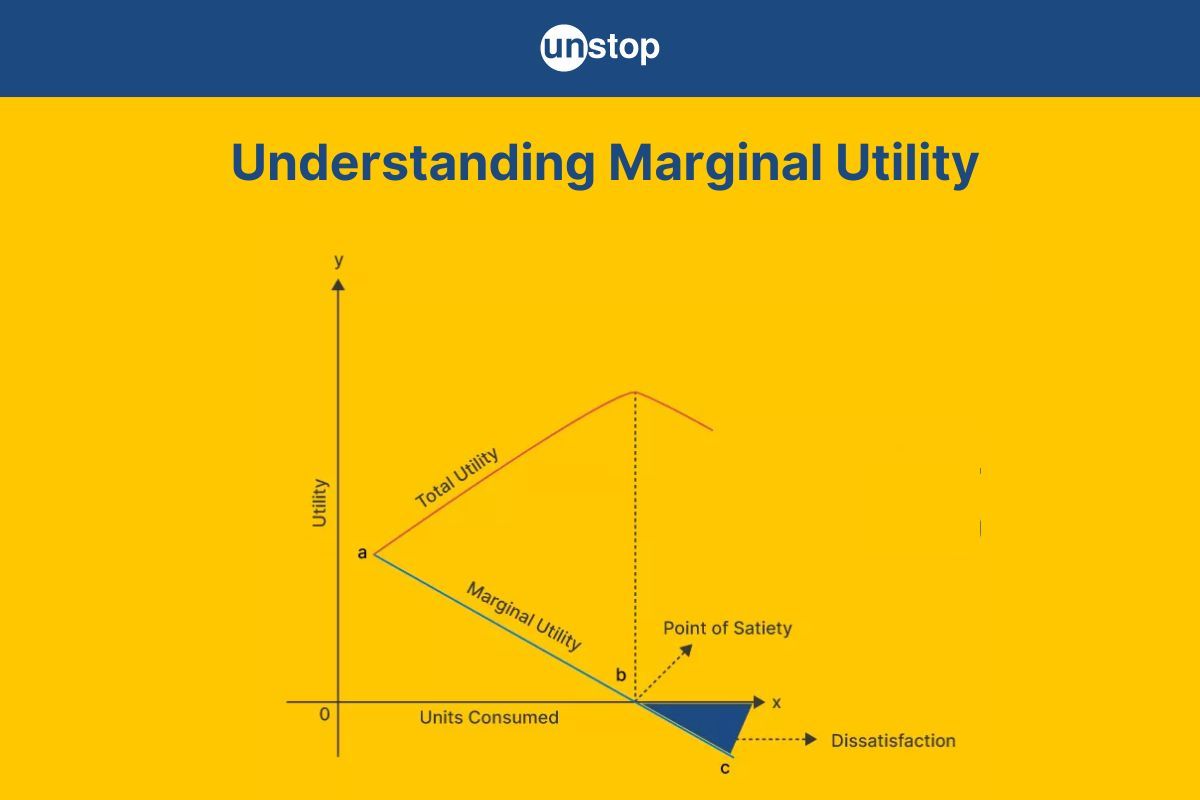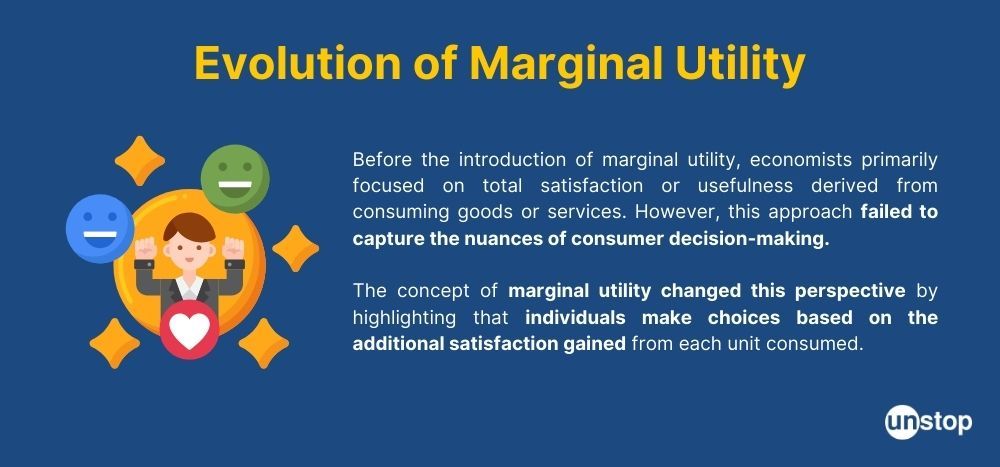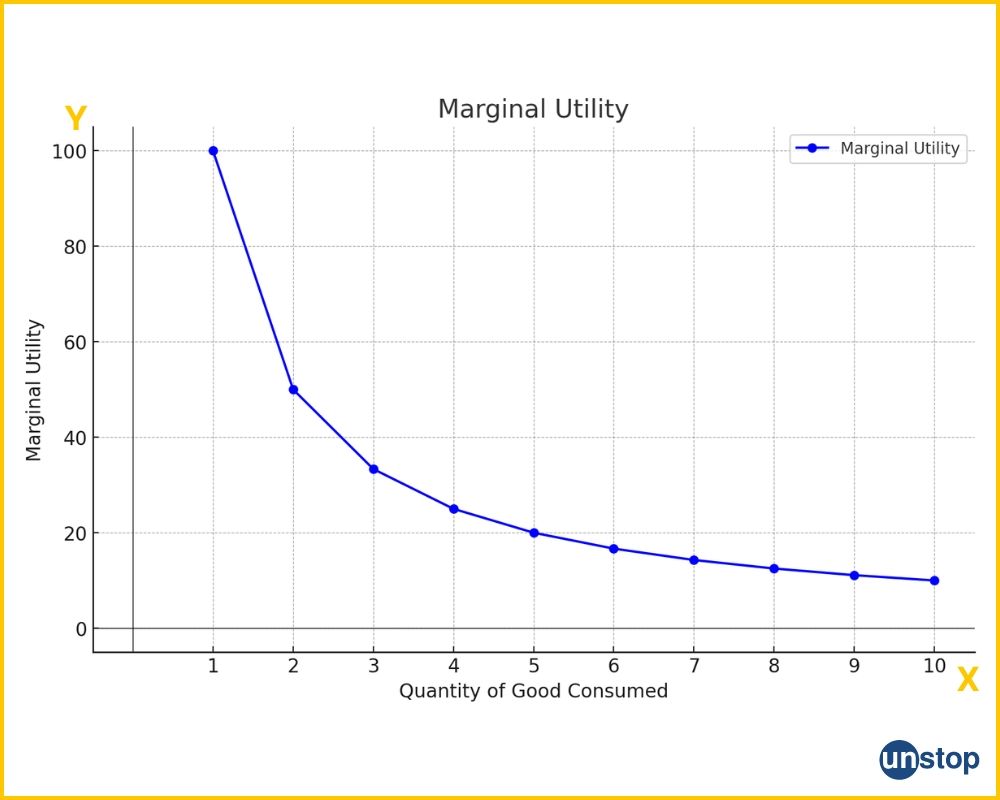- What is Marginal Utility?
- Types Of Marginal Utility
- Marginal Utility & Law Of Diminishing Marginal Utility
- Marginal Utility Formula
- Examples Marginal Utility
- Benefits of Marginal Utility
- Limitations Of Marginal Utility
- Conclusion
- Frequently Asked Questions (FAQs)
Marginal Utility: Definition, Formula, Types & Examples

Imagine that first sip of a cold drink on a scorching day. Amazing, right? But what about the tenth? Not the same level of satisfaction, right? That's marginal utility at play.
This article explores the concept of marginal utility, i.e. how that feeling of satisfaction changes as you enjoy (or endure) more of something.
What is Marginal Utility?
Definition: Marginal utility is the change in total satisfaction or benefit that occurs when consuming an additional unit of a good or service. It quantifies the amount of satisfaction gained from each additional unit consumed.
Importance: Marginal utility helps in understanding consumer behaviour and decision-making. By understanding how individuals allocate their resources to maximize their overall well-being, economists can analyze price determination and market equilibrium and even predict shifts in consumer preferences over time. This knowledge is also vital for businesses to develop retail pricing strategies and for policymakers to make informed decisions about resource allocation in an economy.
The marginal utility analysis is often conducted through indifference curve analysis, which uses ordinal utility and subjective value to understand consumer preferences.
Marginal Utility vs Total Utility
While marginal utility focuses on the incremental change in satisfaction resulting from consuming an additional unit, total utility represents the overall level of satisfaction obtained from consuming a certain quantity of a good or service. It reflects the total amount of happiness or pleasure derived from consuming that particular item.
| Criteria | Marginal Utility | Total Utility |
|---|---|---|
| Definition | Additional satisfaction gained from consuming one more unit of a good or service | Total satisfaction derived from consuming all units of a good or service |
| Calculation | Change in total utility / Change in quantity consumed | The sum of all marginal utilities up to a certain quantity |
| Relationship | Marginal utility diminishes with each additional unit consumed | Total utility increases with each additional unit consumed but at a decreasing rate |
| Focus | Focuses on the incremental benefit of consuming one more unit | Focuses on the overall satisfaction derived from consuming all units |
| Decision-making | Helps in determining optimal consumption levels for maximum satisfaction | Useful in evaluating the overall satisfaction derived from consuming a particular quantity |
| Example | The additional satisfaction gained from eating one more slice of pizza | The total satisfaction derived from eating an entire pizza |
As you consume more units, your total utility generally increases. This is because each additional unit adds to your overall satisfaction. However, it's important to note that while total utility may increase with consumption, there may be diminishing returns over time.
Evolution Of Marginal Utility

The concept of marginal utility, central to economics, has a long and fascinating history. It can be traced back to the works of early economists such as Jeremy Bentham and William Stanley Jevons.
Jeremy Bentham, an English philosopher and economist, was one of the first to introduce the idea of utility in the late 18th century. He believed that individuals make decisions based on the pursuit of pleasure and the avoidance of pain. Bentham argued that the value of a good or service is determined by the amount of pleasure it brings to an individual. However, he did not explicitly define or measure utility quantitatively.
William Stanley Jevons, a British economist, further developed the concept of utility and introduced the idea of marginal utility in the 19th century. Jevons believed that individuals make decisions based on the incremental satisfaction or utility they derive from consuming additional units of a good or service. He argued that the value of a good or service is not determined by its total utility but rather by the additional utility gained from consuming one more unit, known as the marginal utility.
Carl Menger, an Austrian economist, emphasized the subjective nature of utility. He argued that utility is determined by individual preferences and cannot be measured objectively. Menger also introduced the concept of diminishing marginal utility, which states that the additional satisfaction or utility derived from consuming each additional unit of a good or service diminishes over time.
Alfred Marshall, another British economist, played a significant role in developing the concept of marginal utility. He was an economist who contributed to microeconomics in the late 19th and early 20th centuries. Marshall believed that individuals make decisions based on the additional satisfaction or utility they derive from consuming an additional unit of a good or service. Marshall's work on marginal utility laid the foundation for modern economic theories and is a fundamental concept in economics today.
Types Of Marginal Utility
There are three main types of marginal utility:
Positive Marginal Utility
Positive marginal utility occurs when each additional unit consumed increases total satisfaction. For example, imagine you're enjoying pizza. With each bite, your satisfaction increases as you relish the delicious flavours.
Negative Marginal Utility
Negative marginal utility arises when consuming more units, which decreases overall satisfaction. It's like eating too much chocolate - at first, it's enjoyable, but after a certain point, it becomes overwhelming and less enjoyable.
Zero Marginal Utility
Zero Marginal Utility is when additional units consumed provide no extra satisfaction. For example, when consuming an additional slice of pizza provides no extra satisfaction after you're already full.
Marginal Utility & Law Of Diminishing Marginal Utility
The Law of Diminishing Marginal Utility states that the additional satisfaction (or utility) a person derives from consuming an additional unit of a good or service tends to decrease as they consume more of it. This law plays an essential role in determining optimal consumption levels for individuals and society as a whole. It helps balance marginal utility and price.
Marginal utility is the added pleasure you get from using one more unit of a product or service. The law of diminishing marginal utility states that this pleasure tends to lessen with each additional unit you consume.
Here's a sample graph to illustrate this concept:

Axes
- X-axis (horizontal): Quantity of Good Consumed
- Y-axis (vertical): Marginal Utility
Curve
- The Marginal Utility curve slopes downward, indicating that as more units of the good are consumed, the additional satisfaction (marginal utility) decreases.
The graph provided shows the concept of marginal utility. As more of a good is consumed, the curve slopes downward, indicating that the additional satisfaction gained from each extra unit decreases. This illustrates the principle known as the law of diminishing marginal utility.
Balancing Marginal Utility & Price
Consumers decide what to buy based on their perceived benefits and costs. The law of diminishing marginal utility comes into play when consumers evaluate whether buying an additional unit of a product is worth it.
Here's an example: Suppose you love ice cream (who doesn't?). At an ice cream shop, you are deciding whether to buy another scoop. You've already had one scoop which brought you immense pleasure and satisfaction. Getting another scoop might not bring the same enjoyment as the first one. As a result, you may not be willing to pay as much for that second scoop because its marginal utility is lower than the initial scoop.
Determining Optimal Consumption Levels
The law of diminishing marginal utility helps determine optimal consumption levels by considering both the satisfaction derived from consuming additional units and their associated costs.
For instance, let's say you're shopping for shoes online. You find a pair that you really like, and buying one brings you a great deal of satisfaction. However, purchasing multiple pairs might not bring the same level of happiness as the first pair did. At some point, the marginal utility of each additional pair decreases, and you may decide it's not worth spending more on shoes.
Marginal Utility Formula
To understand the concept of marginal utility, economists use a formula that helps quantify the additional satisfaction gained from consuming one more unit of a good or service. This formula, denoted as ∆TU/∆Q, calculates the change in total utility divided by the change in quantity consumed.
The formula for calculating marginal utility enables economists to compare changes in satisfaction across different goods or services. By quantifying these changes numerically, they can determine which products are more valuable to consumers.
Calculation Of Marginal Utility
Calculating marginal utility involves subtracting the initial total utility from the final total utility and dividing it by the change in quantity consumed. This simple formula allows economists to measure and compare changes in satisfaction across different goods or services.
The formula for calculating marginal utility, ∆TU/∆Q, is derived from observing how an individual's satisfaction changes as they consume more units of a particular good or service. By analyzing this change in total utility and dividing it by the corresponding change in quantity consumed, economists can gain insights into consumer behavior.
Examples Marginal Utility
Water is an excellent example to illustrate positive and negative marginal utility. Imagine you're out on a hot summer day and feeling thirsty. You take a sip of water, and the relief is immense - that first sip quenches your thirst significantly! The second sip also brings satisfaction but to a slightly lesser extent than the first one.

Image Credit: Freepik
As you continue drinking more water, however, the increase in satisfaction starts diminishing. This is due to the concept of diminishing returns - each additional unit consumed provides less and less marginal utility compared to the previous ones. Eventually, you may reach a point where consuming more water doesn't provide any additional benefit - and may even become uncomfortable.
Let us take another example of marginal utility. Imagine settling down for a movie marathon with your favourite films lined up back-to-back. As you watch each movie, your enjoyment increases. The first movie sets the mood, and you're excited to dive into the storyline. The second movie builds upon that excitement, adding to your overall satisfaction.

However, as the marathon progresses and you continue watching more movies, there may come a point where fatigue sets in. You might start feeling tired or lose interest in watching more films. This decrease in enjoyment represents negative marginal utility.
Benefits of Marginal Utility
Let's explore how businesses, consumers, policymakers, and economists utilize marginal utility analysis to optimize decision-making and resource allocation.
Optimizing Pricing Strategies & Product Offerings
Businesses play a crucial role in the market economy, and understanding marginal utility helps them make informed decisions about pricing strategies and product offerings. By analyzing the marginal utility of their products or services, companies can determine the optimal price point that maximizes consumer satisfaction while ensuring profitability.
Example: An online streaming platform might analyze users' marginal utility to determine which subscription plans or content offerings generate the most value for customers.
By incorporating consumer preferences and maximizing marginal utility, businesses can enhance customer satisfaction and gain a competitive edge in the market.
Informed Decision-Making & Maximizing Satisfaction
Consumers also benefit from understanding marginal utility as it enables them to make informed decisions about their purchases. By considering the additional satisfaction gained from each additional unit consumed, individuals can allocate their resources effectively to maximize personal satisfaction.
Example: When deciding between two similar products with different prices, consumers can evaluate their respective marginal utilities to determine which option provides greater value for money.
By applying this knowledge to their economic decisions, consumers can avoid overspending on goods with diminishing returns and focus on acquiring items that provide them with higher levels of overall satisfaction.
Resource Allocation & Efficient Taxation Systems
Policymakers rely on an understanding of marginal utility to guide resource allocation in various sectors, such as healthcare, education, and public goods provision. By considering the marginal utility of different resources, policymakers can make informed decisions about where to allocate limited resources to maximize societal welfare.
Example: When designing taxation systems, policymakers consider the concept of marginal utility to ensure that taxes are levied in a way that minimizes negative impacts on individuals' overall well-being while generating necessary revenue for public goods and services.
Understanding Preferences & Market Dynamics
Economists extensively utilize marginal utility analysis to understand consumer preferences and market dynamics. By studying how individuals allocate their resources based on marginal utility, economists gain insights into consumer behaviour and can develop models that explain market phenomena.
For instance, the concept of diminishing marginal utility explains why consumers may be willing to pay higher prices for scarce goods or luxury items with higher levels of perceived satisfaction.
Limitations Of Marginal Utility
While marginal utility provides immense benefits to economists and pricing strategies, it is not entirely free from some limitations. Let us look into some of its limitations and understand it better.
Perfect Knowledge & Assessment
The law of marginal utility assumes that individuals have perfect knowledge about their preferences and can accurately assess the marginal utilities of different goods or services. However, in reality, people often lack complete information about the benefits they derive from consuming a particular item. They may not be aware of alternative options or the potential satisfaction they could gain from other choices.
Influence Of Psychological Factors
Another limitation is that the law overlooks psychological factors that influence decision-making. Emotions, biases, and irrational behaviour patterns can significantly impact an individual's assessment of marginal utility.
For example, someone might choose to buy an expensive designer handbag even if it doesn't provide much additional utility simply because it makes them feel good or boosts their social status.
Exceptions To Diminishing Marginal Utility
While the law generally states that as more units of a good are consumed, the marginal utility decreases, there are exceptions to this pattern. Some goods do not follow the law of diminishing marginal utility. Addictive substances like cigarettes or drugs can actually increase in perceived value with each unit consumed due to physiological dependencies or cravings.
Luxury goods also defy this principle, as consumers may experience increasing satisfaction with each additional unit purchased. For example, owning multiple luxury cars might bring a sense of prestige and exclusivity that enhances one's overall well-being.
Homogeneity Assumption
The law assumes that all units of a good or service are homogeneous, meaning they are identical in terms of quality and characteristics. However, this assumption does not hold true for many products in real-world scenarios.
Furthermore, certain goods may have unique features or attributes that differentiate them from others in the same category. For example, two smartphones may offer similar functionality, but one might have a superior camera or longer battery life. These differences can lead to variations in perceived marginal utility.
Conclusion
In conclusion, understanding the concept of marginal utility is vital for making informed decisions in various areas of life. By grasping how additional units of a good or service affect our satisfaction, we can optimize our choices and allocate resources more efficiently.
The marginal utility provides valuable insights into consumer behaviour, pricing strategies, and resource allocation in economics. Studying the limitations of the law of marginal utility can shed light on cases where this principle may not hold true. By continuing to learn about marginal utility and its implications, you can gain a competitive edge in decision-making processes.
Frequently Asked Questions (FAQs)
1. What is the relationship between total utility and marginal utility?
Total utility represents the overall satisfaction derived from consuming a certain quantity of a good or service. Marginal utility, on the other hand, measures the change in satisfaction resulting from consuming an additional unit. The relationship between these two concepts is that as total utility increases, marginal utility tends to decrease due to the law of diminishing marginal utility.
2. How does marginal utility impact pricing strategies?
Marginal utility plays a significant role in determining optimal prices for goods and services. Companies often use price discrimination techniques based on consumers' varying levels of marginal utilities to maximize profits. By charging higher prices to customers with higher marginal utilities and lower prices to those with lower marginal utilities, businesses can capture more value from each customer segment.
3. Can you provide an example of diminishing marginal utility?
Imagine you are eating your favourite dessert—a slice of chocolate cake. The first bite brings immense pleasure and satisfaction (high initial marginal utility). However, as you continue eating more slices, each subsequent bite yields less enjoyment (diminishing marginal utility). Eventually, you might reach a point where additional bites no longer provide any satisfaction or even become undesirable (negative marginal utility).
4. How can marginal utility be applied in marketing?
In marketing, understanding consumers' marginal utilities can help businesses design effective pricing strategies, develop product bundles, and optimize promotional offers. By analyzing how customers perceive the value of each additional unit consumed or purchased, companies can tailor their marketing efforts to maximize customer satisfaction and drive sales.
5. What are the limitations of the law of marginal utility?
While the law of diminishing marginal utility is widely applicable, it has certain limitations. For instance, it assumes that individuals have perfect information about their preferences and make rational decisions based on them. However, people's preferences may change over time or be influenced by external factors that affect their decision-making process. Some goods or services may not conform to the law of diminishing marginal utility due to unique characteristics or individual circumstances.
Suggested reads:
- Engel's Law Explained: How Income Impacts Your Grocery Bill
- Role Of Soft Skills In Modern Hiring Can't Be Ignored. Here's Why
- Law Of Supply | Definition, Types, Formula And Examples Explained
- Lorenz Curve Is A Measure Of Income Inequality. Here's How It Works
- What Is Gig Economy: Understanding The Meaning, Factors, Types And More!
Instinctively, I fall for nature, music, humor, reading, writing, listening, traveling, observing, learning, unlearning, friendship, exercise, etc., all these from the cradle to the grave- that's ME! It's my irrefutable belief in the uniqueness of all. I'll vehemently defend your right to be your best while I expect the same from you!
Login to continue reading
And access exclusive content, personalized recommendations, and career-boosting opportunities.
Subscribe
to our newsletter
















Comments
Add comment